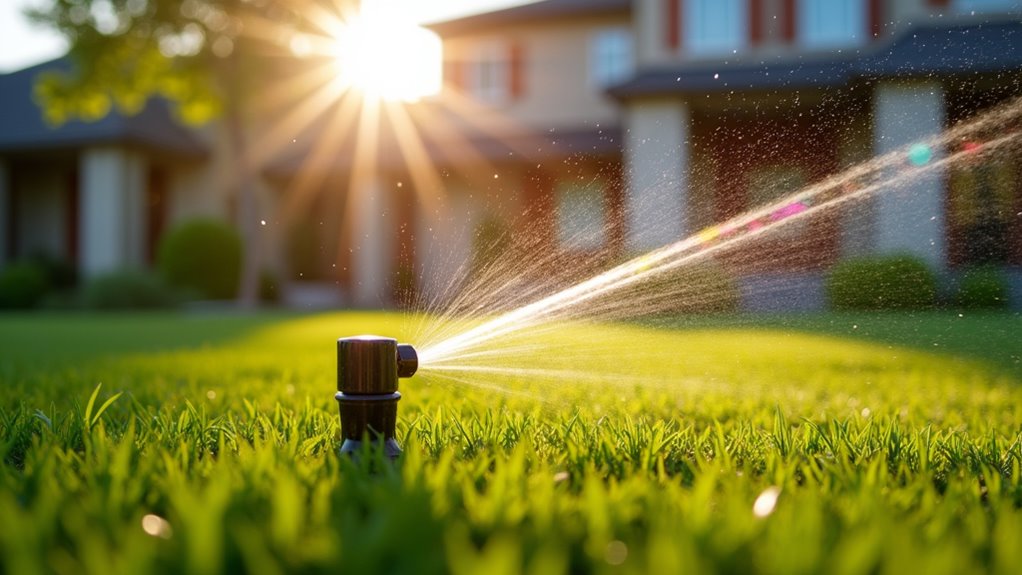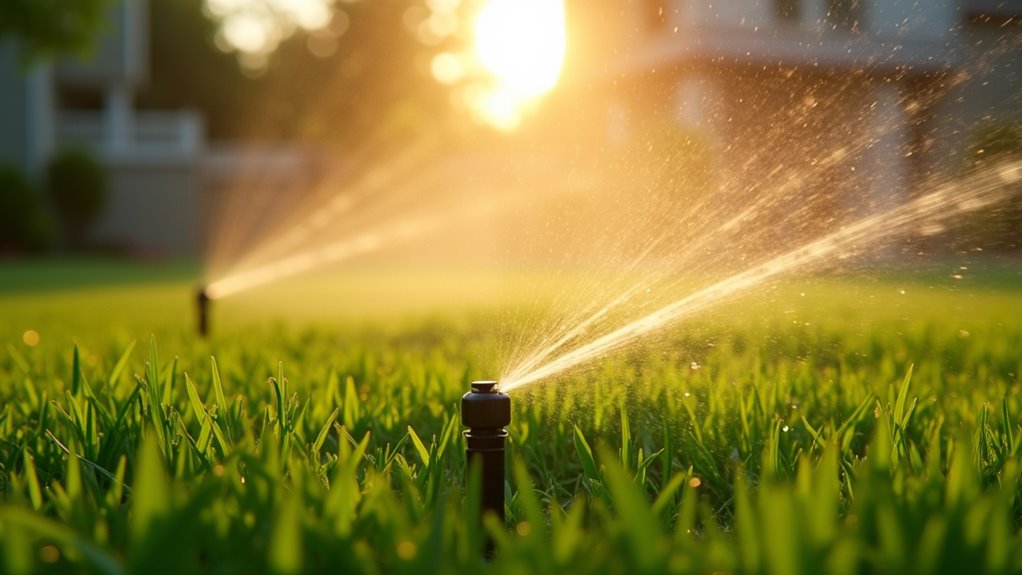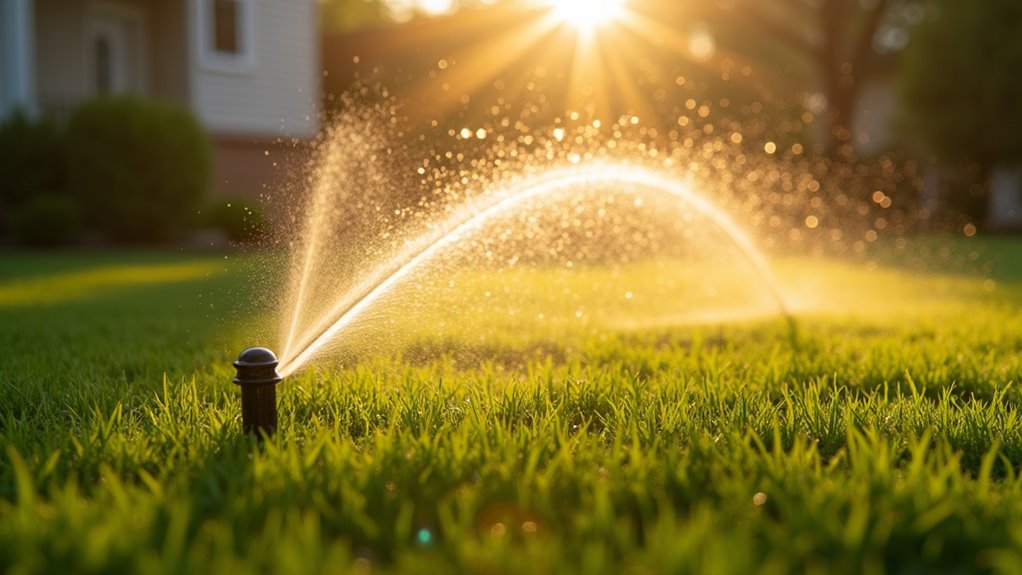You should water your lawn based on seasonal needs: spring requires moderate hydration as soil warms, summer demands 1-1.5 inches weekly during early morning hours, fall needs reduced frequency with deep watering, and winter requires minimal irrigation during dormancy. Monitor for drought signs like footprint persistence and leaf folding, and adjust for rainfall. Smart irrigation controllers and soil moisture sensors can optimize your watering schedule while conserving resources. Uncover how specific timing and techniques can transform your lawn’s health year-round.
Understanding Your Lawn’s Seasonal Water Requirements

Although lawn watering requirements fluctuate throughout the year, understanding these seasonal variations is critical for maintaining ideal turf health. Your grass experiences distinct metabolic and growth changes that directly impact lawn moisture needs across different seasons.
During spring, your lawn enters active growth requiring moderate hydration as soil temperatures rise. Summer demands increase considerably—1 to 1.5 inches of water weekly—as evapotranspiration rates peak under higher temperatures. Fall brings reduced water requirements as growth slows and temperatures moderate, though consistent moisture remains essential for root development. Winter typically requires minimal supplemental irrigation in most climates as dormant grass markedly decreases metabolic activity.
You’ll need to adjust irrigation frequency based on these seasonal patterns, precipitation levels, soil type, and grass species to optimize water efficiency while maintaining turf vigor.
Spring Watering: Balancing Nature’s Rainfall
As spring temperatures initiate new growth cycles, your lawn emerges from dormancy requiring a calibrated irrigation approach that complements natural precipitation patterns. Spring rainfall typically provides substantial moisture, but you’ll need to monitor soil conditions to guarantee ideal hydration without oversaturation.
- Measure soil moisture weekly using a probe inserted 4-6 inches deep; supplement irrigation only when readings fall below 40% moisture content
- Adjust watering frequency based on precipitation data—subtract recent rainfall amounts from your lawn’s weekly 1-inch requirement
- Water during predawn hours (4:00-7:00 AM) to enhance moisture retention and minimize evaporation loss
When spring rainfall exceeds 1.5 inches weekly, suspend supplemental irrigation to prevent root diseases and nutrient leaching. Resume normal watering protocols when soil moisture measurements indicate depletion to critical thresholds.
Summer Irrigation Strategies to Combat Heat Stress

Summer heat demands a fundamental shift in irrigation methodology compared to spring’s naturally supportive precipitation patterns. Water application should occur between 4:00-6:00 AM to minimize evaporation while maximizing root absorption before peak temperatures arrive.
Apply 1-1.5 inches weekly, preferably in two distinct sessions to guarantee proper soil penetration while preventing runoff. During heat stress periods exceeding 90°F, increase frequency rather than volume—shorter, more frequent irrigation cycles prevent soil moisture depletion without encouraging fungal development.
Implement drought management through deep, infrequent watering that encourages downward root growth. Monitor soil moisture at 4-6 inch depth; when 50% depleted, it’s time to irrigate. Clay soils require slower application rates while sandy compositions necessitate more frequent cycles. Adjust your controller’s seasonal adjustment feature to accommodate temperature fluctuations rather than maintaining static programming.
Fall Watering Practices for Recovery and Preparation
When temperatures begin to moderate in early fall, your irrigation strategy should shift in the direction of supporting post-summer recovery while preparing turf for dormancy. Fall recovery requires calculated hydration to strengthen root systems before winter stress occurs. Reduce watering frequency to once every 7-10 days, but maintain adequate soil moisture penetration of 4-6 inches.
Fall irrigation requires strategic reduction to promote recovery and prepare turf for winter dormancy through calculated, less frequent watering.
- Apply 1 inch of water during each irrigation session, preferably between 6-10 AM when evaporation rates are minimal
- Gradually decrease irrigation volume by 25% each month throughout autumn to encourage deeper root development
- Cease irrigation approximately 2-3 weeks before the initial expected frost to promote carbohydrate storage and lawn preparation for dormancy
Monitor soil moisture with a probe test—moist but not saturated soil indicates ideal fall watering conditions.
Winter Watering: The Dormancy Approach

Winter dormancy radically alters lawn watering requirements, shifting from the recovery-focused fall schedule to a minimal maintenance approach. During this period, your grass enters metabolic slowdown, requiring considerably less hydration. You’ll need to water only during extended dry spells when temperatures rise above freezing for several consecutive days.
Proper dormant grass care involves monitoring soil moisture levels rather than adhering to a fixed schedule. When temperatures exceed 40°F with no precipitation for 3-4 weeks, apply approximately 0.5 inches of water during mid-day to allow absorption before potential overnight freezing. This prevents desiccation while respecting the natural winter hydration techniques your lawn requires. Sandy soils may need more frequent attention than clay-based lawns, which retain moisture longer during dormancy periods.
Signs Your Lawn Is Receiving Too Much Water
Excessive irrigation manifests through three critical indicators that require your immediate attention. Fungal pathogens proliferate in oversaturated soil conditions, creating visible mold patches, while compromised root systems exhibit discoloration and mushy texture when extracted from the ground. Standing water or persistent puddles after irrigation cycles constitute definitive evidence of oversaturation, indicating your soil can’t effectively absorb the applied water volume.
Fungal Growth Issues
Despite your best intentions, overwatering your lawn can create ideal conditions for fungal pathogens to proliferate. Excessive moisture in the soil and on grass blades provides the perfect environment for diseases such as brown patch, dollar spot, and pythium blight to develop. Effective moisture management is critical to maintaining turfgrass health and implementing fungal prevention strategies.
Common indicators of fungal invasion include:
- Circular patches of discolored or dead grass that expand over time
- White, gray, or black powdery substances on leaf surfaces, particularly visible in early morning
- Thread-like mycelium growth that appears as cobweb-like structures between grass blades
If you observe these symptoms, immediately reduce watering frequency, improve drainage, and consider applying appropriate fungicide treatments. Proper irrigation timing—early morning rather than evening—helps minimize leaf wetness duration.
Root Rot Symptoms
Beyond fungal growth on grass blades, overwatering can manifest as root rot—a destructive condition that attacks the foundation of your turfgrass system. You’ll identify this problem through specific symptoms that indicate compromised root health.
| Symptom | Description | Root Rot Prevention |
|---|---|---|
| Spongy Texture | Lawn feels soft and waterlogged underfoot | Reduce watering frequency |
| Discoloration | Yellow/brown patches despite adequate moisture | Improve drainage systems |
| Foul Odor | Sulfurous smell indicating anaerobic decomposition | Core aeration annually |
| Stunted Growth | Grass fails to respond to fertilization | Water deeply but infrequently |
| Visible Root Damage | Brown, mushy roots instead of white, firm ones | Test soil moisture before watering |
For effective signs identification, extract a small turf sample with roots intact. Healthy roots appear white or tan with numerous fine root hairs, while rotted roots display dark coloration, sloughing tissue, and lack structural integrity. Implement preventative measures immediately upon detection.
Puddles After Watering
Standing water that forms puddles on your lawn after irrigation represents one of the most visible indicators of overwatering. These puddles occur when soil becomes saturated beyond its infiltration capacity, preventing water absorption and leading to surface accumulation. Persistent puddle formation damages turf by creating anaerobic soil conditions and inhibiting oxygen exchange at the root zone.
Monitor your lawn for these critical signs:
- Water runoff flowing onto hardscapes or neighboring areas, indicating the soil can no longer absorb irrigation
- Depressions retaining water for more than 4 hours after irrigation has ceased
- Spongy soil texture when walking across affected areas, accompanied by visible water expression under foot pressure
Adjusting your irrigation schedule by reducing watering duration or implementing cycle-soak methods can effectively mitigate puddle formation while maintaining adequate soil moisture levels.
Recognizing Drought Stress in Different Seasons
Recognizing drought stress requires different assessment techniques as seasons change throughout the year. You’ll observe slower recovery timing in cool-season grasses during summer heat, while warm-season varieties exhibit stress primarily in spring and fall shifts. Visual assessment techniques—including monitoring for folding leaves, bluish-gray coloration, and footprint persistence—provide reliable indicators regardless of seasonal variations.
Seasonal Drought Indicators
As seasons change throughout the year, your lawn exhibits distinct drought stress symptoms that require different monitoring approaches. Effective drought detection methods vary by season, with each period demanding specific attention to seasonal moisture indicators.
- Spring drought signs – Look for slowed growth rates, delayed green-up, and patchy coloration. Soil moisture retention differs markedly as temperatures fluctuate, requiring probing 4-6 inches deep to assess moisture levels accurately.
- Summer drought indicators – Monitor for footprint persistence (grass that doesn’t spring back), blue-gray coloration, and leaf folding or rolling. These symptoms emerge faster in high temperatures.
- Fall/winter drought markers – Watch for desiccation in dormant lawns, brittle grass blades, and prolonged winter dormancy. Cold-season drought often goes undetected but can greatly impact spring recovery.
Grass Recovery Timing
While your lawn struggles under drought conditions, understanding recovery timing becomes essential for implementing appropriate irrigation interventions. Cool-season grasses typically exhibit visible grass stress within 2-4 days of moisture deprivation, requiring immediate watering to prevent dormancy. Once wilting occurs, you’ll need 7-14 days of consistent irrigation to achieve full recovery.
Warm-season varieties demonstrate greater drought tolerance, often surviving 3-7 days without considerable moisture before displaying stress symptoms. Their recovery time extends from 5-21 days depending on damage severity. Temperature extremes greatly impact these timeframes—recovery periods double during peak summer heat (above 90°F) compared to moderate spring conditions. Monitor blade rebound after foot traffic; slow recovery indicates drought stress has progressed beyond initial stages, necessitating a modified watering schedule to restore turf health.
Visual Assessment Techniques
How effectively you respond to lawn drought stress depends primarily on accurate visual identification across seasonal variations. Recognizing moisture deficiency through visual cues requires systematic observation of your turf’s condition throughout the year.
- Spring/Summer: Look for darkening color with a bluish-gray cast, folded leaf blades, and footprints that remain visible after walking across the lawn (indicating decreased cellular turgor pressure).
- Fall: Monitor for slowed recovery from traffic damage, persistent wilting despite cooler temperatures, and uneven coloration patterns signaling variable moisture levels in soil substrates.
- Winter: Assess dormant lawns for desiccation symptoms including brittle leaf tips, soil cracking around root zones, and prolonged dryness during thaw periods when transpiration may occur without adequate root uptake.
These indicators enable timely irrigation interventions before significant physiological damage occurs.
Water Conservation Techniques for Year-Round Lawn Care
Implementing strategic water conservation techniques can greatly reduce consumption while maintaining a healthy lawn throughout all seasons. Install rainwater harvesting systems to collect precipitation from downspouts and gutters, storing this valuable resource for dry periods. This practice reduces municipal water dependency by 30-50% during summer months.
Maintain ideal soil moisture by applying organic mulch to reduce evaporation rates. Schedule irrigation during pre-dawn hours (4:00-6:00 AM) when wind speeds are minimal and evaporation potential is lowest. Utilize smart irrigation controllers that adjust watering schedules based on weather data and soil moisture sensors.
Convert high-water sections to drought-tolerant species, particularly in zones receiving excessive sunlight. Aerate compacted soil annually to improve water penetration and reduce runoff by up to 40%.
Regional Considerations for Seasonal Lawn Watering
Your lawn’s watering requirements vary considerably based on your regional climate zone, with arid regions demanding more frequent irrigation than humid areas. You’ll need to adapt your watering schedule seasonally, accounting for precipitation patterns, temperature fluctuations, and evapotranspiration rates specific to your geographic location. Local water restrictions and conservation ordinances may limit your irrigation options during drought conditions, requiring compliance with designated watering days or volume limitations established by municipal authorities.
Climate Zone Impacts
While lawn care fundamentals remain consistent across regions, climate zones greatly determine ideal watering schedules and techniques. Your location’s climate variability effects create distinct watering requirements that optimize turf health while conserving resources.
- Arid/Desert Zones (Zones 7-10): Water deeply but infrequently (2-3 times weekly) during pre-dawn hours (4-6am) to minimize evaporation. These regions experience high transpiration rates requiring 1.5-2 inches weekly during peak summer.
- Temperate Zones (Zones 5-6): Adjust according to seasonal regional moisture levels. Spring requires 1 inch weekly, while summer demands 1.5 inches. Fall returns to 1 inch until dormancy.
- Cool/Humid Zones (Zones 1-4): Reduce frequency to 0.5-1 inch weekly, primarily during morning hours. Excessive moisture in these zones promotes fungal development.
Local Watering Restrictions
Regardless of climate zone classification, municipal water regulations often supersede ideal lawn care schedules. You’ll need to consult your local water authority for specific ordinances that may restrict irrigation to designated days or hours. These regulations typically intensify during summer months when water conservation becomes critical.
Many municipalities implement odd-even watering systems based on street addresses, while others enforce complete irrigation bans during severe drought conditions. Violation of these local watering practices can result in substantial fines. Seasonal restrictions commonly appear in tiered structures, with increasing limitations as water scarcity escalates.
Adapt your maintenance calendar by incorporating these regulations into your seasonal watering strategy. Consider collecting rainwater or installing smart irrigation controllers that automatically adjust to both weather patterns and compliance with local restrictions, ensuring legal adherence while maintaining lawn health.
Smart Technology and Irrigation Systems for Seasonal Adjustments
As seasons change throughout the year, maintaining ideal irrigation efficiency requires systematic adjustments to watering schedules and durations. Modern smart sensors measure soil moisture levels, ambient temperature, and precipitation data to automatically modify irrigation parameters according to actual environmental conditions rather than predetermined schedules.
- Weather-responsive controllers integrate with local meteorological data feeds to suspend irrigation during rainfall events and adjust water volume based on evapotranspiration rates.
- Soil moisture sensors placed at varying depths (2-6 inches) transmit real-time hydration data, enabling irrigation automation systems to activate only when moisture falls below species-specific thresholds.
- Zone-specific programming allows customization of water delivery based on microclimate variations, sun exposure, and plant typology within your environment, optimizing resource allocation throughout seasonal changes.



